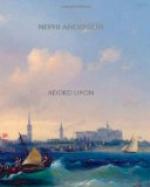During this visit the good seed was planted, from which in due time the Lord gave an abundant harvest from among the Bogstad family and its many ramifications.
One day in the temple Rachel met Signe Dahl Ames. It was Rachel’s custom to keep a lookout for sisters who were new to the work that she might assist them. Signe had not been in the Temple since the day she was married, and now she had come to do some work for her family. Rachel met her in the outer room with a pleasant greeting.
“I am Sister Bogstad,” she said; “and what is your name?”
“Bogstad, did you say—why—why, my name is Ames.”
“Yes, Bogstad,” replied Rachel, noticing the sister’s surprise. “We haven’t met before, have we?”
“No; I think not. The name is not common, and I used to know a gentleman by that name—that’s all.”
“You’re a Norwegian,” said Rachel.
“Yes.”
“So am I; though I was born in this country, it may be possible that I belong to the family which you know.”
“I used to know Henrik Bogstad of Nordal, Norway.”
“That’s my cousin. We have been doing work here in the temple.”
Signe was greatly surprised, and Rachel led her to a corner where they talked freely for some time. During the day they found occasion to continue their conversation, and that evening Signe went home with her new-found friend.
This was the beginning of a beautiful friendship. Rachel knew enough of Henrik’s little romance with Signe to make the acquaintanceship unusually interesting; besides, there came to be a strong affinity between the two. Rachel accompanied her friend to Dry Bench, and there soon became “Aunt Rachel” to Signe’s four beautiful children. Then she wrote to Henrik, telling him of her wonderful “find.” He replied that at their next visit to America, they would surely give Dry Bench a call.
Henrik, Marie, and two of the older children came that fall when the peaches were ripe and the alfalfa fields were being cut. And such delicious peaches, and such stacks of fragrant hay they found! Amid the beautiful setting of the harvest time, their several stories were told, in wonder at the diverging and the meeting of the great streams of Life. The Bogstad children practiced their book-learned English, while the Ames children were willing teachers. The boys bathed in the irrigation canal, rode on the loads of hay, and gorged themselves with peaches. The girls played house under the trees. And were it part of this story, it might be here told how that, later, Arnt Bogstad and Margaret Ames loved and mated—but it is not.




